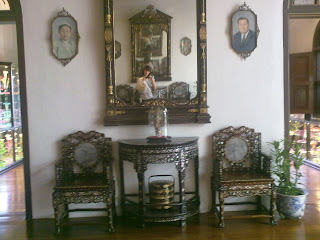If you ask any of your classmates or friends around you about Penang, the first thing that you would hear from them is the praises of the delicious mouth-watering food that Penang has to offer. Besides the must not missed food, another vital knowledge you have to know about is the peranakan trail in Penang!
If you ever want basic knowledge about the Penang peranakan, you should visit the Pinang Peranakan Mansion, which is located very near to SEGi Penang. It is open from 9.30 am to 5pm and adults needs to pay RM10 as entry fees, lucky for children it is free admission for them.
This is the main entrance of the Pinang Peranakan Mansion. The bright colors and complicated carvings brings out the peranakan taste so much so that you can feel like you are in a totally different world, a good short term escape from the hectic reality we are facing currently.
Well, behind this beautiful walls not only consist of the antiques and artefacts, but also the history and memories that have been kept and protected like precious gems.
As you enter the mansion, you will see a big compound with plants decorated at the sides of the place. This mansion is a double story mansion, so you willnot have to worry about walking and climbing till you tire out.
There is no top roof at the centre of the compound, so if it rains, you will get wet.
I also noticed that the settings of the furniture in the Peranakan house are very spacious, but the designs and carvings are complicated.
There are around 3 dining rooms and more than 1 living room in this mansion.
Beautiful carvings surround the balcony at the centre of the compound on the 1st floor.
More beautiful yet complicated furniture that is seated in each room that we enter. There are lots of pictures of the peranakan ancestors, that hung on each corner of the mansion, which is a little creepy when you are alone.
This is the main room of the mansion where wedding accessories and items are kept. Two wedding gowns are displayed on the bed here, and beside the bed there is a dressing table that has perfumes, “bedak sejuk” which is a kind of cooling powder, and accessories of the peranakan bride. I did not manage to capture photos of it as Photography is not allowed in the mansion.
This is one of the modern wedding gown which was worn by one of the peranakan people decades ago.
If you want to taste the typical Penang peranakan food in Selangor, you can try Nyonya Imperial restaurant in Puchong.
~No.1 Jalan Puteri 2/6,
Bandar Puteri,
47100 Puchong,
Selangor
I was told by the waiter that the difference between the Penang peranakan food and Melacca peranakan food is that, Penang peranakan food is more to the Chinese tasten and contains more Asam in their cooking, whereas Melacca peranakan food is more to the Malay taste.
If you ever go to Penang, check out the Penang peranakan mansion and also other heritage site as it is a worth seeing and appreciating the history, especially the peranakan history.






































